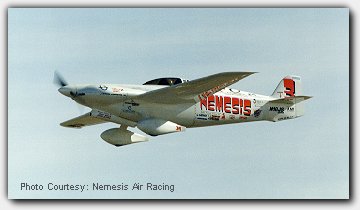NEMESIS
By: Connie Pardew
Aviation/Features Writer
His record breaking Formula One plane will be at the Smithsonian's new annex at the Air and Space museum in Washington D.C., but Jon Sharp of Mojave, Calif. and his Nemesis racing team are continuing to bring innovations to the world of flight with their Nemesis NXT kit plane.
Deemed as the plane that can get you fast from the shortest distance  between two points, the kit plane is based on the revolutionary Nemesis Formula One racer, which began its career in 1991.
between two points, the kit plane is based on the revolutionary Nemesis Formula One racer, which began its career in 1991.
Sharp, 52 is a composites research engineer for Lockheed Skunk Works in Palmdale, Calif. and has been actively competing in Formula One racing for more than 20 years.
Nemesis brought him 16 world speed records and nine consecutive Reno National Air Race Gold Championships.
Sharp got the racing bug as a young boy when he competed in Go-Kart, model airplane and drag racing.
In his first air race, Sharp placed fourth in a modified Cassutt111M model, in Mexicali, Mexico in 1978.
Both in 1982 and 1986, Sharp and his Cassutt won the national championship races in Reno, Nev.
In 1989, Sharp decided to devote all his vigor to a new all-composite model of his own design. He appeared two years later in Reno with the Sharp DSR-90.
Since then, his team has been awarded four Pulitzer aviation trophies for breaking race records and three Bleriot medals awarded by the Federation Aeronatique International.
In its nine consecutive wins, Nemesis averaged a speed of 244.68 mph.
After Nemesis' retirement in July 2000 at the EAA Oshkosh AirVenture, Sharp and his wife, Patricia decided to dedicate their time and energy to building the Nemesis NXT kit planes.
Jon and Patricia, along with a group of contract workers and volunteers operate out of their hangar in Mojave, Calif.
The Nemesis NXT made its debut in at the May 2002 at the Society of Advancement of Material and Processing (SAMPE) Engineering convention in Long Beach, Calif.
The kit plane weighs 1,200 pounds empty and 2,200 pounds loaded. Sharp plans to fly it over the Mojave desert this summer.
"The NXT is like Nemesis on steroids," he said.
This high performance, precision crafted kit should be able to reach a speed of 350 mph at sea level.
Formula One racing was established in 1947 and has been evolving over the years with top racers using NASA technology to reach top speeds of 300 mph.
According to the International Formula One organization, all racers must be powered by a 200 cubic inch Continental engine (the same 100 Hp engine used in a Cessna 150 trainer).
The weights and size of every major part must be within stock limits.
The cam profile and carburetion are strictly controlled. The racers must have at least 66 square feet of wing, weigh at least 500 pounds empty, and have fixed landing gear and a fixed pitch propeller.
International Formula One is one of only four organizations in the United States authorized by the F.A.A. to organize and run air races.
In its lifespan, hundreds of Formula One's have raced in meets throughout the United States, Mexico and Canada.
This year Sharp hopes to race again at September's Reno National Championship Air Races.
Plans are also in the works to fly the NXT at Oshkosh this year at the EAA fly in.
"Basically the Nemesis NXT is designed for the pilot to get from point A to point B-fast," said Sharp.
Potential owners will use the plane for closed course and cross-country racing.
"The plane is designed for speed," he said.
"The Nemesis team utilizes what they call Perfect Fit Technology (PFT) which saves time for the assembler. It's a process that make all the parts fit well, perfectly out of the box."
They use this process on all wind swept manufacturing breaks such as cowling upper/lower fuselage interface, canopy frame, access panels and doors, gear doors and slip flaps, said Sharp.
The PFT controls step and gap size down to thousandths of inches rather than 1/16's.
"It greatly reduces time on assembly by eliminating the steps of sanding and trimming," he said.
The kit does not include power plant, props and avionics, but Sharp recommends the Teledyne Continental turbocharged 550 engine and the IO-550 N engines.
Its wingspan measures 24 feet with a length of 23 feet.
After the Nemesis' last flight in July 2000 in Oshkosh the legendary airplane, forefather of the new kits planes was retired.
The Sharps donated it to the National Air and Space Museum
Nemesis now waits for its at new home at the Steven F. Udvar-Hazy Center at Dulles International Airport in Northern Virginia.
The facility will house more than 100 spacecraft and 180 aircraft.
The Center will open its doors to the public in 2003 in time to celebrate the 100th anniversary of the first manned flight by the Wright brothers.
####
© Copyright 2001-, Dreamland Resort. All rights reserved. See a broken link or error - please email the webmaster. Page last modified 12/27/2021






 between two points, the kit plane is based on the revolutionary Nemesis Formula One racer, which began its career in 1991.
between two points, the kit plane is based on the revolutionary Nemesis Formula One racer, which began its career in 1991.

